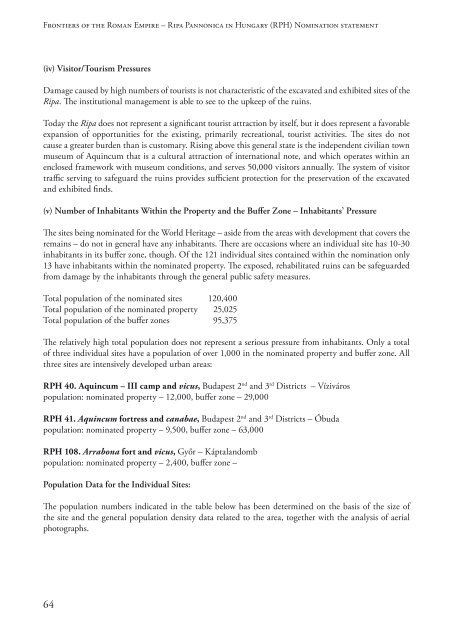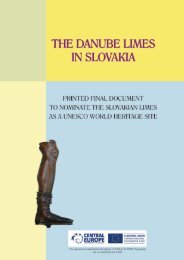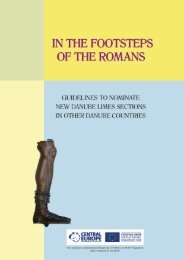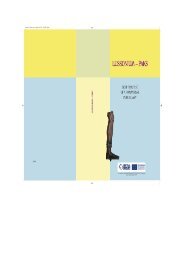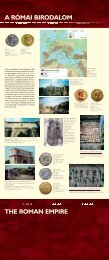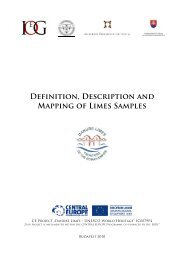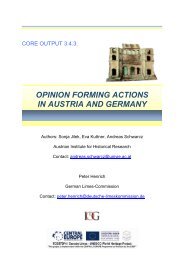the PDF version! - Danube Limes
the PDF version! - Danube Limes
the PDF version! - Danube Limes
Create successful ePaper yourself
Turn your PDF publications into a flip-book with our unique Google optimized e-Paper software.
Frontiers of <strong>the</strong> Roman Empire – Ripa Pannonica in Hungary (RPH) Nomination statement<br />
(iv) Visitor/Tourism Pressures<br />
Damage caused by high numbers of tourists is not characteristic of <strong>the</strong> excavated and exhibited sites of <strong>the</strong><br />
Ripa. The institutional management is able to see to <strong>the</strong> upkeep of <strong>the</strong> ruins.<br />
Today <strong>the</strong> Ripa does not represent a significant tourist attraction by itself, but it does represent a favorable<br />
expansion of opportunities for <strong>the</strong> existing, primarily recreational, tourist activities. The sites do not<br />
cause a greater burden than is customary. Rising above this general state is <strong>the</strong> independent civilian town<br />
museum of Aquincum that is a cultural attraction of international note, and which operates within an<br />
enclosed framework with museum conditions, and serves 50,000 visitors annually. The system of visitor<br />
traffic serving to safeguard <strong>the</strong> ruins provides sufficient protection for <strong>the</strong> preservation of <strong>the</strong> excavated<br />
and exhibited finds.<br />
(v) Number of Inhabitants Within <strong>the</strong> Property and <strong>the</strong> Buffer Zone – Inhabitants’ Pressure<br />
The sites being nominated for <strong>the</strong> World Heritage – aside from <strong>the</strong> areas with development that covers <strong>the</strong><br />
remains – do not in general have any inhabitants. There are occasions where an individual site has 10-30<br />
inhabitants in its buffer zone, though. Of <strong>the</strong> 121 individual sites contained within <strong>the</strong> nomination only<br />
13 have inhabitants within <strong>the</strong> nominated property. The exposed, rehabilitated ruins can be safeguarded<br />
from damage by <strong>the</strong> inhabitants through <strong>the</strong> general public safety measures.<br />
Total population of <strong>the</strong> nominated sites 120,400<br />
Total population of <strong>the</strong> nominated property 25,025<br />
Total population of <strong>the</strong> buffer zones 95,375<br />
The relatively high total population does not represent a serious pressure from inhabitants. Only a total<br />
of three individual sites have a population of over 1,000 in <strong>the</strong> nominated property and buffer zone. All<br />
three sites are intensively developed urban areas:<br />
RPH 40. Aquincum – III camp and vicus, Budapest 2 nd and 3 rd Districts – Víziváros<br />
population: nominated property – 12,000, buffer zone – 29,000<br />
RPH 41. Aquincum fortress and canabae, Budapest 2 nd and 3 rd Districts – Óbuda<br />
population: nominated property – 9,500, buffer zone – 63,000<br />
RPH 108. Arrabona fort and vicus, Győr – Káptalandomb<br />
population: nominated property – 2,400, buffer zone –<br />
Population Data for <strong>the</strong> Individual Sites:<br />
The population numbers indicated in <strong>the</strong> table below has been determined on <strong>the</strong> basis of <strong>the</strong> size of<br />
<strong>the</strong> site and <strong>the</strong> general population density data related to <strong>the</strong> area, toge<strong>the</strong>r with <strong>the</strong> analysis of aerial<br />
photographs.<br />
64


